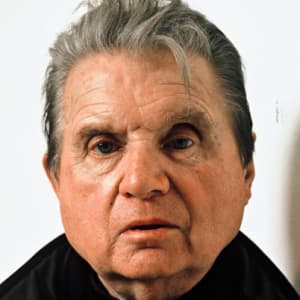
Francis Bacon
Artist Francis Bacon is best known for his post-World War II paintings, in which he represented the human face and figure in an expressive, often grotesque style.
Synopsis
Francis Bacon was born to English parents living in Dublin, Ireland, on October 28, 1909. After traveling to Germany and France as a young man, he settled in London and began a career as a self-taught artist. Most of his paintings from the 1940s to '60s depict the human figure in scenes that suggest alienation, violence and suffering. Bacon's provocative, expressive work is considered some of the most important art of the postwar era. He died in Madrid, Spain, on April 28, 1992.
Early Life and Artistic Beginnings
Francis Bacon was born to English parents living in Dublin, Ireland, on October 28, 1909, and is the collateral descendant and namesake of the famed 16th-17th century philosopher. Bacon was raised in Ireland and England, and as a child, he suffered from asthma, which kept him from receiving a formal education. Instead, he was tutored at home.
Bacon left home in 1927 at just 17 years old, with his parents not accepting his sexuality. He traveled to Berlin, Germany, where he took part in the city's gay nightlife as well as its intellectual circles, and to Paris, France, where he became further interested in art through visits to galleries. When Bacon returned to London in the late 1920s, he began a short career as an interior decorator, also designing furniture and rugs in a modern, Art Deco-influenced style. Additionally, he began to paint, first in a Cubist style influenced by Pablo Picasso and later in a more Surrealist manner. Bacon's self-taught work attracted interest, and in 1937, he included in a London group exhibition entitled "Young British Painters."
Paintings of the 1940s and '50s
Francis Bacon later dated the true beginning of his artistic career as 1944. It was around this time that he devoted himself to painting and began creating the works for which he is still remembered, with "Three Studies for Figures at the Base of a Crucifixion" seen as a major turning point. His large canvases depicted human figures—most often a single figure isolated in an empty room, in a cage or against a black background. For one series of paintings, Bacon was inspired by Diego Velázquez's portrait of Pope Innocent X (circa 1650), but he painted the subject in his own style, using dark colors and rough brushwork and distorting the sitter's face. These works came to be known as Bacon's "screaming pope" paintings.
In other works, a figure might stand beside a flayed carcass of meat. Still other paintings were derived from traditional religious subject matter. In all of his paintings, Bacon emphasized the universal experiences of suffering and alienation.
Art and Life after 1960
Even during a period in which modern art was dominated by abstraction, Bacon continued to paint the human face and figure. His emotional use of brushwork and color as well as his exaggeration of forms caused him to be labeled as an Expressionist artist, though he rejected the term.
Some of Bacon's works of the 1960s depict a lone male figure dressed in a business suit. Others showed nude figures, often with grotesquely altered proportions and features. Bacon used brighter colors at times, but themes of violence and mortality were still central to his art. He also frequently painted portraits of people he knew, including fellow artist Lucian Freud and George Dyer, who met Bacon upon attempting to rob the painter's home.
(Bacon and Dyer went on to become lovers in a relationship marked by great tumult. Dyer at one point framed Bacon for drug possession and later committed suicide. Their time together was depicted in the 1998 film Love Is the Devil: Study for a Portrait of Francis Bacon, starring Derek Jacobi, Daniel Craig and Tilda Swinton.)
Bacon, who was known for his carousing, maintained a home and a notoriously cluttered studio in London, and continued to paint until the end of his life. While on holiday, he died in Madrid, Spain, on April 28, 1992, at the age of 82.
Legacy
Francis Bacon is considered one of Britain's major painters of the post-WWII generation, as well as an important influence on a new generation of figurative artists in the 1980s. His work is owned by major museums around the world, and he has been the subject of several retrospective exhibitions. His studio was acquired by the Hugh Lane Gallery in Dublin, where it has been recreated as a room for visitors to view. Bacon's "Three Studies of Lucian Freud" broke the record for the most expensive work ever sold at auction in 2013, when it was purchased for a final price of $142.4 million at Christie's in New York.



